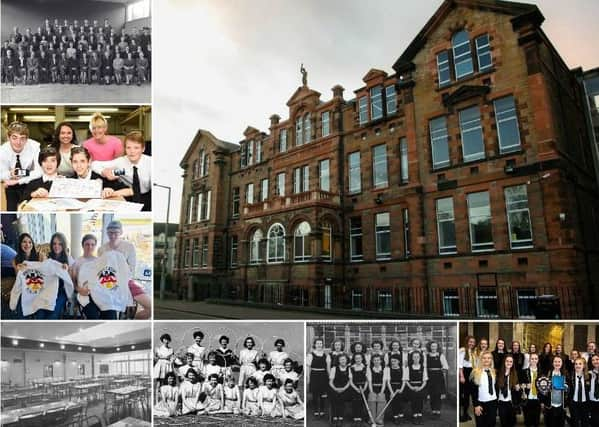Trinity Academy celebrates its 125th anniversary


To mark this milestone, lots of exciting events are planned throughout the 2018-2019 academic year.
These will begin with a Family Fun Day at Bangholm playing fields on Saturday, September 1 and a more formal gathering on Tuesday, September 4, the date when the school opened in 1893.
Advertisement
Hide AdAdvertisement
Hide AdA community celebration will take place at the school from 6pm on Friday, September 7, featuring an outdoor sing-a-long, silent disco and barbecue.
There will also be opportunities throughout the year for former pupils and teachers to meet up. For information and updates check the TA 125 Facebook page or email [email protected] to note your interest.
When the building of Trinity Academy started on July 11, 1891, it should have been with the traditional dram over the foundation stone - laid with full Masonic honours by Leith School Board chairman Robert Somerville.
But his wife was a temperance supporter and would not allow it.
Advertisement
Hide AdAdvertisement
Hide AdInstead, each man received a book, From Dark to Dawn in Fiji, and the enterprise was launched into the late Victorian age on the era’s twin pillars of Empire and disciplined self-improvement.
Building delays, which were to characterise the century to come, led to the original contractors being struck off the Board’s list, but on September 4, 1893, Craighall Road School, as it was first known, was opened with Thomas Trotter, formerly of North Fort Street, as Rector. With a frontage deemed ‘of a superior kind to most other schools’ it had cost £18,850 and five shillings, (excluding the purchase of the land from the Laird of Bonnington, James Clerk-Rattray) and had all modern conveniences - electric bells and voice tubes connecting the Rector’s room to the classes and Cowan’s patent gas lamps throughout!
The formal opening of the building was carried out by social and educational reformer, Miss Flora Stevenson on February 1, 1894, and in June 1895 the first 127 pupils were presented for Leaving Certificates in Mathematics, Arithmetic, English, French and German - 81 successfully.
Inspectors were openly critical in those days - ‘grammar needs smartening... sluggishness in oral work’ - but the school’s reputation grew.
Advertisement
Hide AdAdvertisement
Hide AdIn 1901, the year of Queen Victoria’s death, the school became Trinity Academy under the new Rector, Thomas Duncan.
Edwardian inspectors were increasingly enthusiastic but the Great War loomed, a conflict which was to claim 71 former pupils and two teachers out of some 300 who served.
As early as 1919 Trinity began to outgrow its main building and plans were drawn up for a new secondary block. It was to take forty-three years! In the meantime, access to Bangholm was negotiated. In 1925 James Scott arrived as Rector and the following year the house system was created.
Plans for a new block were again on the drawing board when the Second World War broke out. Many pupils were evacuated to Macduff on the Moray Firth until normal classes resumed in 1941. The following year Dr Albert Weir became Rector and at the height of hostilities, in September 1943, the school celebrated its fiftieth anniversary. In this war Trinity lost 62 former pupils.
Advertisement
Hide AdAdvertisement
Hide AdPost-war landmarks during the rectorship of Alexander Neill between 1953 and 1969 were the completion of the new secondary block in March 1962 and the removal of the primary school from the huts at Bangholm to the new school on Newhaven Road in January 1968. Trinity’s sixth rector, William Brodie, arrived in 1969 at a time when educational tides were turning, fees were being phased out, and the days of selective schooling in the public sector were numbered.
In September 1974, Trinity Academy merged with David Kilpatrick’s to become a fully comprehensive secondary serving North and West Leith, Newhaven and Trinity.
Adjustment was difficult at times and there was the added inconvenience of running a split site, first with the David Kilpatrick building and then, after 1981, with the Holy Cross annexes.
Declining school rolls across the city even led to the possibility of closure of the school or of merger with Leith Academy. However, there was life in Trinity yet.
Advertisement
Hide AdAdvertisement
Hide AdThe objective of the subsequent Rectors, Peter Galloway and Alec Morris, was to combine the best elements of Trinity’s traditions with the aspirations and methods of a modern comprehensive.
In 1993, coinciding with the school’s Centenary celebrations, an additional new block was added on the site of the former tennis courts. This now provides facilities for the teaching of science, music and FCT.
With pupil numbers on the increase, and with the school on a single site (and the only state secondary school in Edinburgh to continue to occupy its original building), there are proposals to expand and redevelop Trinity Academy, to make it fit for the students of the 21st century.
As the current Rector, Bryan Paterson, says: “Trinity Academy is a real community school with a big heart, a wonderful sense of tradition and a keen eye to the future. Our commitment for every single student is to build a culture of “only the best will do in all that we do”, supporting and challenging students to achieve the best possible outcomes and promoting a real sense of ambition and excellence for all.
Advertisement
Hide AdAdvertisement
Hide Ad“In our anniversary year the school has achieved excellent examination results and developed a wide range of programmes to meet the needs of all our students. In other words, Trinity Academy is a school that is seriously going places – and for everyone!”